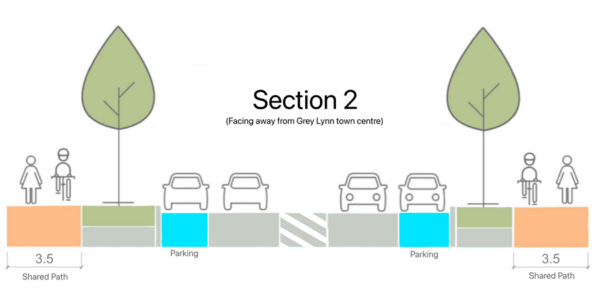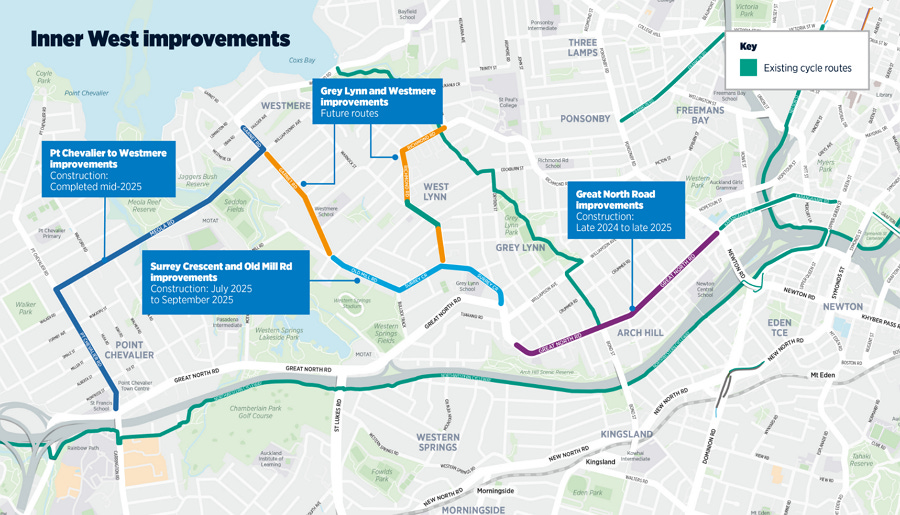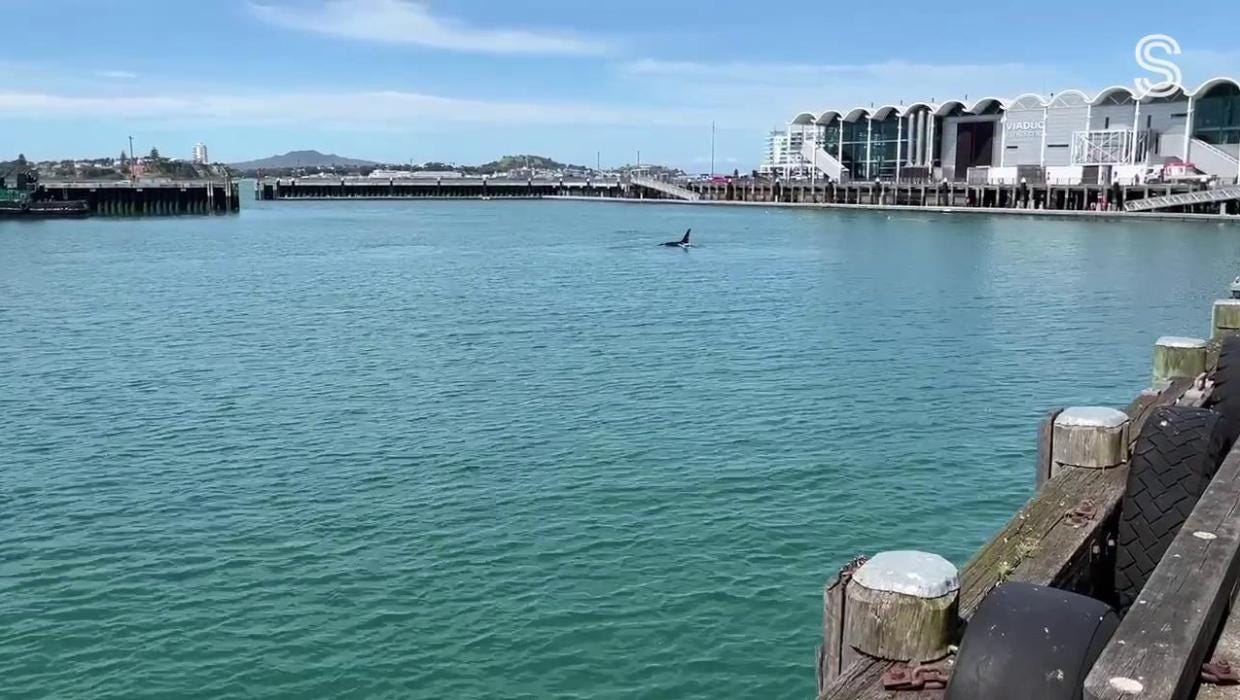It’s another Friday and it has been a big week in Auckland. We hope everyone's excited to be in the final stretch of the year! Here’s some of the stories that have caught our attention this week.
This week in Greater Auckland
On Monday Connor outlined how we fix the City Centre's transport issues (hint we already have the plan for it).
On Tuesday Matt celebrated Great North Road improvements (finally) starting.
On Wednesday Matt examined the good, bad, and (potentially) ugly aspects of the proposed Auckland Transport changes.
On Thursday Patrick looked at the potential of passenger rail to Hamilton, and how to stage it.
Submit on the Albany Highway consultation!
Auckland Transport are consulting on closing the notorious walking and cycling gap along Albany Highway that was highlighted by Shaun Baker in this post - though point out that the work is unfunded and likely will be for a long time based on current government policy.
We’re working to improve safe walking and cycling connections across Tāmaki Makaurau.
Albany’s population is growing. We’re investigating a safe walking and cycling network along Albany Highway, between Bush Road and Sunset Road, and some parts of Goldfinch Rise.
We know parts of Albany Highway have no footpaths on either side of the road, which makes it difficult for people to walk safely locally or to bus stops.
We want you to share your thoughts in our survey below on how you travel in our project area including how we can improve:
Footpaths and cycleways options between Bush Road and Sunset Road
Crossing options over Albany Highway to make it safer for you to walk in your local area
Cycling connections between SH18 cycleway, Glenfield Road and Unsworth Reserve
Your local knowledge about how you would like to walk and cycle will help us shape our designs, which can be built over time as funding becomes available
.....
You can influence the following key elements in our investigations that will help shape the final outcome:
Crossing locations – Areas where you often need to cross the road and feel unsafe to do so.
Shared paths – these are wide paths designed with enough room for people walking and cycling to share.
Improving safety – which means separating people on foot and cyclists from the busy main roads. This requires us to clear access and reallocate road space which will remove some on-street parking areas.
Wayfinding – if there is a location around the roadway or other areas that you think wayfinding signs should be included.
Protected cycle lanes – these are bike lanes separated from traffic by rubber or concrete barriers.
[Matt] As someone who cycles through here multiple times a week, upgrading the horrific Albany Hwy/Upper Harbour Dr intersection is critical along with footpaths and cycleways. Here is a quick clip from early September showing what it's currently like.
Surrey Crescent and Old Mill Rd Improvements coming
As well as Gt North Rd finally starting, AT are also gearing up to deliver on some other improvements in the Inner West.
The Surrey Crescent and Old Mill Rd improvements includes footpath upgrades, cycling paths, new road surfacing and improved pedestrian crossings. It is cost-effective, quick and easy to implement with work starting in July 2025 and finishing in September 2025.
The road surface will also be improved throughout the route as the project is being combined with planned maintenance which minimises construction time and cost.
We have done extensive engagement with the local community on improving this area since 2016 and we have incorporated this feedback into our latest plans. There is great local support for the project, with the community asking us to start it as soon as possible. Check out the full plans or see the overview below.
The changes we're making
There will be space for people to walk and cycle along the whole route on both sides of the road.
Cycle lanes on the road.
Cycle lanes on the berm.
A shared walking and cycling path.
Improvements to pedestrian crossings.
Raising the pedestrian crossing at Grey Lynn School entrance.
Road narrowing outside Grey Lynn School.
New road surface.
Trial 5min pick up, drop off outside the Grey Lynn School.
With Pt Chev to Westmere, Gt North Rd and this, the inner west is inching closer to having a connected network.
Our presence in the media this week
With the enormous changes to transport governance in Auckland through the proposed changes to AT, we've been fielding a fair few requests in the media for comment. While overall the change seems good, there's a few things that are cause for concern.
See Matt's comments here on Stuff as well as on RNZ about the risk we get a post code lottery for safe streets and cycleways due to potentially more political decisions being made from devolving power to local boards.
Connor wrote and op-ed for The Post, asking some questions of the change, and the risk of central overriding local government.
The Spinoff highlights the absurdity of the bus bike rack ban
The Spinnoff has covered the bus bike rack ban.
A bike rack on a bus is a simple solution to any number of problems. Maybe your bike has a flat tyre and you forgot to bring a repair kit. Or maybe it’s started pouring and the thought of riding to uni in the rain is unappealing, but the weather will be better in the afternoon. Maybe you’re still getting used to biking uphill, and the prospect of a ride in a bus on the way home is good encouragement to cycle down to the city. Maybe you want to drop your kid off at school on the bus; maybe you live on the other side of a tunnel or bridge that bikes can’t go on; maybe you want to get out of the city and want to bus to somewhere more quiet for a peaceful bike ride.
Whatever the reason that putting your bike on a bus is appealing, it’s currently not an option anywhere in the country. On November 8, a complete restriction on front-mounted bike racks on buses began, everywhere in the country. This followed an initial night-time ban that came in on November 2.
Auckland ranks as the 47th best city in the world to visit or live
Recently Marketing companies Ipsos and Resonance produced a report for the best cities in 2025. As the NZHerald reports, London came out on top, while Auckland was all the way in 47th.
It turns out the most people friendly places gave us a good score, with the downtown redevelopment and waterfront getting big props. It'll be interesting to see how the opening of the CRL changes things in 2026.
Aotearoa didn’t make the top 10, or the top 20. Our biggest city, Auckland, ranked just inside the top 50 at 47th, up from last year’s 64th spot.
Auckland was ranked the best city in the world for air quality and the sixth best for labour force participation.
“New Zealand’s largest and most cosmopolitan city balances modernity with natural beauty,” read the entry. It also said the renewed Britomart and Viaduct Harbour, as well as the new Commercial Bay area, have “transformed” the city’s downtown area.
It also called out the City Rail Link, saying it would “dramatically improve transit connectivity across the city” once it’s complete in 2026.
While it was the 16th most “livable” city, it was not particularly “lovable” or “prosperous”, ranking 69th and 99th, respectively.
Prosperity reflects the relative strength of human capital and was calculated using several metrics, such as GDP per capita, labour force participation, percentage of the population with a bachelor’s degree and poverty rate.
The kids know what's up
A primary-aged student concerned about accidents outside of his rural south Auckland school is urging local politicians to lower the speed limit.
Presenting a petition to the Franklin Local Board through board member Gary Holmes, Caio Maffey said something needed to be done about speeding.
The 9-year-old is a student at Awhitu District School, and started a petition for speed reduction measures on the 60km/hr rural road, which doesn't have restrictions during school hours
"There have already been car accidents outside the gate," Maffey said.
"I think that if we put speed bumps outside the gate, cars will have to slow down and it will make it safer for kids and parents."
He said he was going to present his petition to his Auckland Council representatives and members of Parliament.
Another safety project canned
Improving the Hill St intersection has been on the plans for a long time and it now looks like it'll stay on the plans for longer still with Waka Kotahi pulling funding from it despite AT saying they expected to start construction last month.
An upgrade to simplify an Auckland intersection infamous for its confusing layout has been pushed back, again.
The Hill St intersection in Warkworth has long frustrated motorists, locals and visitors alike, with its 55 different turning combinations into Pūhoi, Wellsford, Matakana and Snells Beach.
It is frequently referred to by locals as New Zealand’s “worst intersection”.
.....
Auckland Transport and New Zealand Transport Agency Waka Kotahi have pondered options for an upgrade since at least 2010, spending millions on project investigations and proposals.
In its latest project update in November 2023, AT said it had settled on a plan to replace the intersection with two roundabouts, teasing that construction could begin within 12 months.
However, that plan has too come to a screeching halt, with funding for the project shelved in the 2024 Governement Policy Statement (GPS) on land transport until at least 2027, a NZTA spokesperson said.
Should there be an upper age limit for driving?
An interesting question out of Australia, should we have a maximum age for driving?
Drivers have to obey speed limits, which are signposted along roadsides and above multi-lane highways.
When it comes to age limits, however, the situation is a little more complicated.
States and territories across Australia are fairly consistent at the younger end of the driving spectrum. In most, you can start preparing for the road at 16.
But jurisdictions differ much more markedly in their expectations regarding older drivers — a state of affairs which doesn't reflect what University of New South Wales dementia expert Kaarin Anstey describes as the "U-shaped curve" in road crash stats.
"The drivers who have the most crashes are the young drivers up to [the age of] 25, and then the older drivers particularly in their 80s and over, but it does start to creep up in the 70s," she said.
.....
Studies have repeatedly reported an over-representation of older Australians in fatal crash statistics.
The most recent national crash data shows that of the 1,295 Australians killed on the roads in the past year, more than a fifth (294) were aged 65 or above.
A joint paper by UNSW and National Seniors Australia noted that the over-70 age group not only had fatality rates "equivalent to those of drivers aged 17-25", but that they were at higher risk of serious injury because of frailty.
"The most common crash for an older driver is turning right," Professor Anstey told ABC Radio.
The New Zealand data groups everyone over the age of 60 and that group account for about 11% of the population but over a quarter of the deaths on our roads.
Bike lane ramp going ahead on Sydney Harbour Bridge
Sticking with Australia, the bike lane over the Sydney Harbour Bridge is getting a much needed upgrade (see if you can spot the Nimby cutaway).
So Eke Panuku was right
A few weeks ago Stuff ran a story highlighting support but also concerns with the concept plans for Te Ara Tukutuku, the planned headland park at the tip of Wynyard Point, in particular commenting about the images showing Orca in the area.
If there’s a perfect symbol for the far-reaching aspirations of Auckland’s $320 million proposed new waterfront park and mixed use development, it’s perhaps the frolicking whales.
Highly-stylised renders show a lush pōhutukawa forest on a peninsula surrounded by leaping dolphins, jubilant orca and baleen whales spouting geysers.
Perhaps it wasn't far off after all as Stuff reported on Monday about orca just off North Wharf.
Making Bridges Car Free
Some interesting posts from the socials
Reminder by Oliver Bourgeois to think about why we feel how we do
If you catch yourself with a polarizing thought, like "there is a war on cars", stop for a second and take a deep breath. Go outside and observe. Does reality seem to agree with the thought?
In Slate, I explained why a newborn, job change, or closed highway can disrupt our travel habits, leading us to form new ones – and perhaps leave the car at home. It’s a lesson with major implications for policy.
Have a great weekend.












